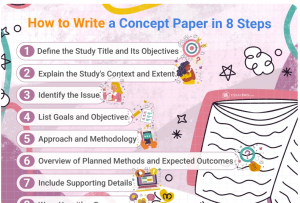Overview of Planned Methods and Expected Outcomes
Overview of Planned Methods and Expected Outcomes
In this step of how to write a concept paper for research, you’ll provide an overview of the specific methods you plan to use and outline the expected outcomes or results.

Start by summarizing the methods you’ll employ to collect data. This may include qualitative methods such as interviews or focus groups, quantitative methods such as surveys or experiments, or a combination of both. Briefly explain why you’ve chosen these methods and how they align with your research goals.
Next, outline the planned steps for implementing each method. Describe the procedures you’ll follow to collect and analyze data, including any tools or instruments you’ll use.
After detailing your methods, discuss the expected outcomes or results of your research. What do you hope to learn or discover through your study? How will your findings contribute to existing knowledge in your field?
Be realistic in your expectations and consider potential challenges or limitations that may affect your results. By acknowledging these factors upfront, you demonstrate a thoughtful and nuanced understanding of your research process.
Include Supporting Details
Here, you’ll enrich your concept paper by incorporating supporting details that bolster your argument and provide additional context for your research.
Start by providing relevant background information or literature reviews that support your research topic. This could include citing key studies, theories, or concepts that inform your understanding of the issue.
Next, consider including any relevant data, statistics, or examples that illustrate the significance of your research topic. This could involve presenting findings from previous studies, real-world examples, or case studies that highlight the need for further investigation.
Additionally, discuss any theoretical frameworks or conceptual models that underpin your research approach. How do these frameworks help guide your study and shape your research questions?
Finally, be sure to cite your sources properly using the appropriate citation style (e.g., APA, MLA). This demonstrates academic integrity and allows readers to verify the information you’ve presented.
Wrap Up with a Summary
In this final step, you’ll bring your concept paper to a close by summarizing the key points and reinforcing the significance of your research.
If you’re uncertain how to write a conclusion for an essay, start by briefly recapping the main elements of your concept paper, including the research topic, objectives, methodology, and expected outcomes. This helps reinforce the central message of your paper and reminds readers of the key insights you’ve presented.
Next, reiterate the importance of your research topic and its potential impact within your field. Emphasize how your study fills a gap in existing knowledge or addresses a pressing issue, highlighting the relevance and significance of your research.
Finally, conclude with a call to action or a thought-provoking statement that encourages further reflection or discussion. This could involve suggesting avenues for future research, proposing practical implications for policymakers or practitioners, or inviting readers to consider the broader implications of your findings.
Concept Paper Example
Now that we’ve explored the steps and tips for writing a concept paper let’s put theory into practice. In this section, we’ll provide you with a concept paper example to illustrate how these principles can be applied in a real-world scenario.
Mental Health Support
What is the Primary Purpose of a Concept Paper
Sourr
